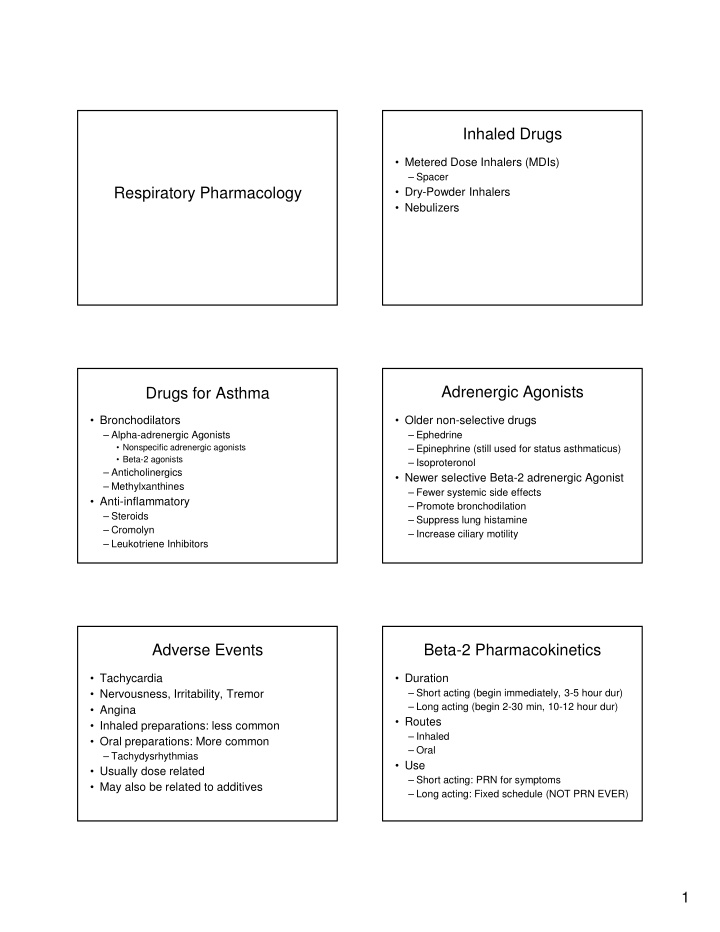



Inhaled Drugs • Metered Dose Inhalers (MDIs) – Spacer Respiratory Pharmacology • Dry-Powder Inhalers • Nebulizers Adrenergic Agonists Drugs for Asthma • Bronchodilators • Older non-selective drugs – Alpha-adrenergic Agonists – Ephedrine • Nonspecific adrenergic agonists – Epinephrine (still used for status asthmaticus) • Beta-2 agonists – Isoproteronol – Anticholinergics • Newer selective Beta-2 adrenergic Agonist – Methylxanthines – Fewer systemic side effects • Anti-inflammatory – Promote bronchodilation – Steroids – Suppress lung histamine – Cromolyn – Increase ciliary motility – Leukotriene Inhibitors Adverse Events Beta-2 Pharmacokinetics • Tachycardia • Duration • Nervousness, Irritability, Tremor – Short acting (begin immediately, 3-5 hour dur) – Long acting (begin 2-30 min, 10-12 hour dur) • Angina • Routes • Inhaled preparations: less common – Inhaled • Oral preparations: More common – Oral – Tachydysrhythmias • Use • Usually dose related – Short acting: PRN for symptoms • May also be related to additives – Long acting: Fixed schedule (NOT PRN EVER) 1
Agents Dosing • Short acting • Albuterol MDI: usually 1-2 puffs Q 4-6 hrs – Albuterol (Proventil, Ventolin): MDI, neb – Deep exhale – Levalbuterol (Xopenex): neb only – Inhale and puff – Bitolterol (Tornalate): neb only – Hold breath for slow ten count – Pirbuterol (Maxair): neb only – Exhale slowly • Long Acting – Wait one minute before second puff – Salmeterol (available only in combination) – Use spacer – Formoterol (Foradil Aerolizer): DPI • Dry Powder • Oral – Usually one inhalation, not a puff – Albuterol: Tablets, Extended tabs, syrup – One smooth continuous inhalation – Terbutaline: Tablets Anticholinergics Anticholinergics • Anticholinergics (atropine derivative) • Ipratropium (Atrovent) • Approved only for COPD bronchospasm but – Onset 30 minutes; lasts 6 hours used in asthma also – MDI, Neb – Combivent MDI: combo with albuterol • Reduces bronchospasm and mucus – Also available intranasally for allergic • Few systemic side effects rhinitis • Tiotropium (Spiriva) – Newer, lasts longer – Dry Powder Inhaler (Handi-haler) 2
Methylxanthines Methylxanthines • Primary actions • Theophylline and Aminophylline – CNS excitation – Oral – Bronchodilation – IV (dangerous, usually aminophylline) • Other actions – Longer duration – Metabolized in liver, variable half-life – Cardiac stimulation – Requires periodic blood level monitoring – Vasodilation – Toxicity: NVD, restlessness, dysrhythmias, – Diuresis seizures • Usually considered third line – Interactions: caffeine, Tagamet, – High side effect profile fluoroquinolones, other CNS drugs – Narrow therapeutic range Glucocorticoids Glucocorticoids • Decrease release of inflammatory mediator • Systemic • Decrease infiltration and action of WBCs – Stronger effects – Action unaffected by lung restriction • Decrease airway edema – More side effects, esp with long term therapy • Decrease airway mucus production • Inhaled • Increase number of beta-2 receptors – Localized action • Increase sensitivity of beta-2 receptors – Fewer side effects: some absorption occurs – Disease may prevent penetration of drug to affected areas Adverse Events Inhaled Corticosteroids • Inhaled: gargle and use spacer • Fluticasone (Flovent) MDI – Oral candidiasis – Advair Diskus DPI (combo with salmeterol) – Dyphonia • Flunisolide (Aerobid) MDI • General • Budesonide (Pulmicor Turbohaler) DPI,neb – Adrenal suppression • Beclomethasone QVAR (MDI) – Bone loss: exercise, Vit D, calcium • Triamcinolone (Azmacort) MDI – Slow growth in children, but not ultimate height • Almost all of these also have intranasal – Increase risk of cataracts and glaucoma preparations for allergic rhinitis – PUD 3
Mast Cell Stabilizers • Used for prophylaxis, not acute treatment – Seasonal allergy – Exercise induced asthma – Can be used intranasally for allergic rhinitis • Stabilizes mast cells – Prevents release of histamine, inflam mediators – Inhibits eosinophils, macrophages • MDI – Cromolyn – Nedocromil Leukotriene Modifiers Asthma Treatment • Two approaches • Mild Intermittent – Inhibit leukotriene synthesis – Albuterol MDI PRN • Zileuton • Mild persistent – Inhibit leukotriene receptors – Add anti-inflammatory • Zafirkulast (Accolate) • Moderate Persistent • Montelukast (Singulair) (fewest drug interactions); – Increase dose of anti-inflammatory also works for allergic rhinitis • � inflammation, bronchoconstriction, edema, – Multiple anti-inflammatory mucus, recruitment of eosinophils – Long acting beta-2 antagonist • Severe persistent asthma – High inhaled steroids, or systemic steroids COPD Treatment Allergic Rhinits Medications • Similar to asthma, difference is damage is • Antihistamines progressive and irreversible • Intranasal Glucocorticoids – Ipratropium • Intranasal Cromolyn – O2 in advanced disease • Montelukast (Singulair) • Sympathomimetics (Decongestants) 4
Cough Suppressants Decongestants (Antitussives) • Opioid • Pseudoephedrine – Codeine and Hydrocodone • Phenylephrine Neo-Synephrine (PO & spray) – Reduce cough reflex centrally • Oxymetazoline (Afrin) nasal spray • Non-opioid • Phenylpropanolamine (taken off market) – Dextromethorphan (DM) • Effects • Codeine derivative – Vasoconstriction of nasal arteries • Reduces cough reflex centrally • Less euphoria, inhibits Cytochrome P-450 – Shrinkage of swollen membranes – Adverse: tachycardia, � BP (caution HTN), – Benzonatate (Tessalon pearls) irritability, insomnia, rebound (topical) • Local anesthetic • Decreases stomach receptor sensitivity; do not chew Expectorants • Only one is effective: Guaifenasin – Need higher doses than usally present in OTC – 100-200mg OTC (q12 hours) – 600-1200mg RX (q12 hours) • Mucolytics: thin mucus – Hypertonic saline & Acetylcysteine • Both can cause bronchospasm • Normal saline (inhaled) – Used to hydrate lung 5
Recommend
More recommend